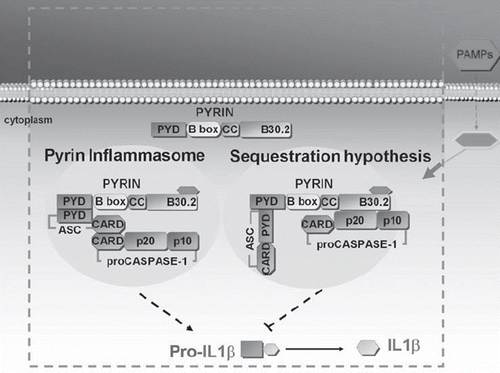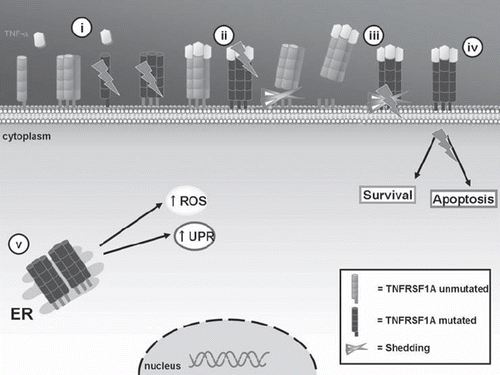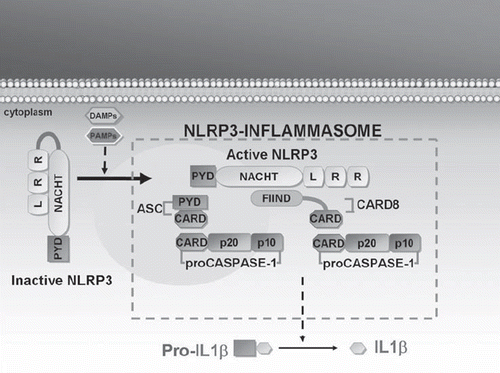Figures & data
Table I. Descriptive summary of the systemic autoinflammatory diseases.
Figure 1. Proposed mechanisms of pyrin action in FMF. Pyrin inflammasome hypothesis: Pyrin can assemble the ‘inflammasome’ complex through pyrin–pyrin domain interaction with ASC, resulting in activation of caspase-1. Sequestration hypothesis: Pyrin has an inhibitory effect on caspase-1-mediated activation of IL-1β by competitive binding of ASC, as well as caspase-1. (PAMPs = pathogen-associated molecular patterns; PYD = pyrin domain; B-box = B-box zinc finger; CC = coiled-coiled region; ASC = apoptosis-associated speck-like protein containing a CARD; CARD = caspase recruitment domain; IL = interleukin).

Figure 2. Mechanisms of TNFRSF1A action in the pathogenesis of TRAPS. The TNF receptor (TNFRSF1A) participates in the regulation of inflammatory responses through TNF-α binding. TRAPS-associated TNFRSF1A mutations may present alterations in: i) receptor trafficking to the cell surface; ii) TNF-α binding; iii) activation-induced shedding of the receptor; iv) TNF-α induced activation of transcription factors or apoptosis; and v) accumulation of aberrant receptors in the ER with increased formation of ROS and activation in UPR. (TNF = tumor necrosis factor; ER = endoplasmic reticulum; ROS = reactive oxygen species; UPR = unfolded protein response).

Figure 3. Mechanism of NLRP3 action in the pathogenesis of CAPS. Cryopyrin (or NLRP3) plays a key role in the inflammatory response by regulating IL-1β secretion. At rest, NLRP3 is inactive. Upon NLRP3 activation by means of agonist recognition, as with PAMPs (such as muramyl dipeptides, lipopolysaccharide, peptidoglycan, bacterial or viral RNA) and DAMPs (such as uric acid, ATP, or ultraviolet B radiations), NLRP3 interacts with several proteins (such as ASC and CARD8) to form the NLRP3–inflammasome: this multimolecular complex leads to caspase-1 activation, which in turn catalyzes the processing of IL precursor to IL-1β. (IL = interleukin; PAMPs = pathogen-associated molecular patterns; DAMPs = damage-associated molecular pattern molecules; PYD = pyrin domain; NACHT = nucleotide-binding oligomerization domain; LRR = leucine-rich repeat; ASC = apoptosis-associated speck-like protein containing a CARD; CARD = caspase recruitment domain; CARD8 = caspase recruitment domain family, member 8; FIIND = function to find domain).
